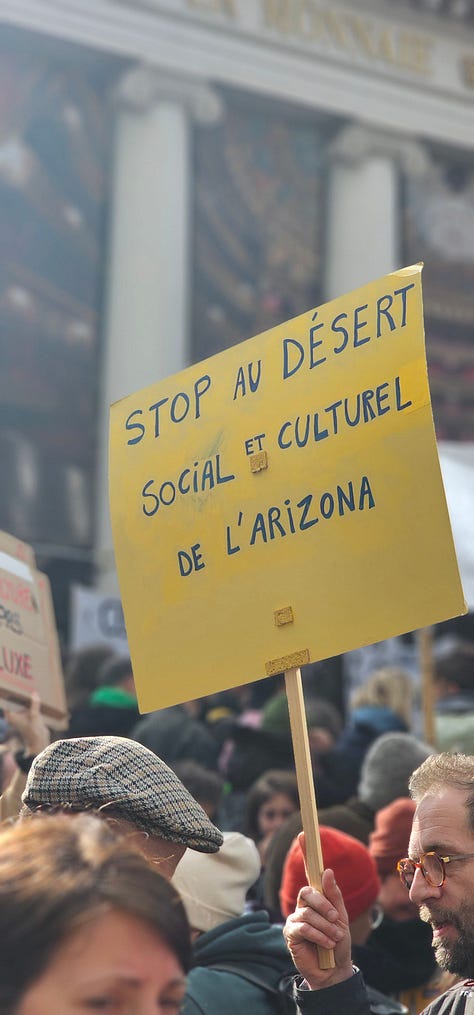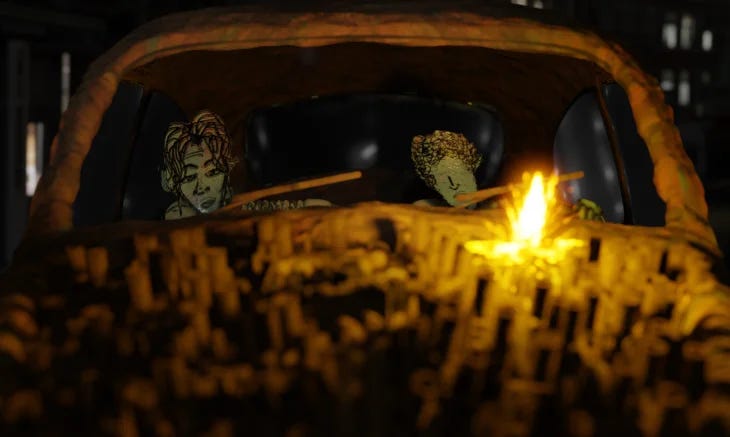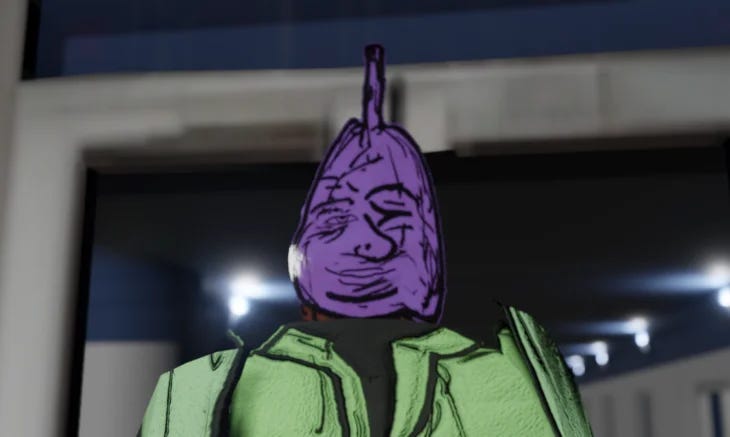Between Strikes and Promising Student Shorts : A Jump Into Belgian Animation's Future
A Belgian social welfare system is in trouble, and it may affect the whole animation industry. Including upcoming filmmakers such as Quirijn Dees, winner of the Best Student Short Film at Anima 2025.
Hello to all animation fans and professionals, from sunny Brussels. This happens rarely in Belgium, and I have to say it’s a joy to be able to sunbathe and recharge our vitamin-D deprived Belgian bodies. Yet not is all happy and cheerful as we start this newsletter, although things might turn out okay in the gloomy world we live in now.
A Dry Monday for Culture…
On Monday, March 31, hundreds gathered in front of La Monnaie/De Munt, Brussels’ Opera House to protest against the new measures from what is now known as the ‘Arizona’ Government in Belgium. According to the workers’ union, it had been long since such a crowd fought together, be them Flemish or French speaking artists and cultural workers.
An omen for change? 195 years ago, it was right in this very opera house that the spark for Belgian revolution ignited. Precisely on August 25, 1830, at a show of La muette de Portici, an Opera written by French composer, director and artist Daniel Auber.
An artist that would not be able to thrive under the new conditions of our Federal government, which threaten to undo the entire system of ‘Kunstwerkuitkering / Statut d’artiste’. A specific Belgian social welfare system where artists who have been recognised as “kunstwerker / travailleur.euse dans les arts” (artists/working within the arts sector) can apply for temporary unemployment benefits in the event of unemployment. A status that is now under scrutiny, in the context of a nation-wide limitation of unemployment benefits to a maximum of two years.
This safety net is important. Hell, it is crucial for artists — and animators — who struggle more often than not to find regular income and stability in a tumultuous market. How can creativity thrive if one has to worry inconsistent income, with dire consequences?
I was there on Monday to support those claims, standing aside those who drive our creative animation landscape. Because what would I write about, if there are no more animators?
Getting out there, for what was one my first real protest gathering, was truly inspiring and filled me with energy and happiness. ‘United we stand’ is Belgium’s motto. And on Monday, that’s what I witnessed. Hopefully, as She-Ra, we’re gonna win in the end.
If you want to support Belgian artists, you can sign this petition here, launched by Flanders’ Green Party.



…but a Bright (And Also Tiny Bit Weird) Future Ahead
Protecting animation artists and their status also means letting creativity flow freely. And sometimes, it takes the weirdest shapes.
In Pubert Jimbob, KASK-student Quirijn Dees brings us into a short that is as inventive as it is eccentric, enough to charm fans of gore and dark humor while also being an impressive visual and artistic offering. The short, which received the Award for Best Belgian Student Short at Anima 2025, was also saluted last year in Annecy, and has proven to be a real crowd-pleaser in festivals.
After Anima, I spoke with Quirijn about this wonderful quirky film. In the upcoming weeks, other interviews from the other Anima winners will follow!
In the meantime, you can discover the interview below, along with the short’s trailer.
What compelled you to write this story?
Quirijn Dees: For the story, I wanted to combine and concatenate a variety of ideas into one linear narrative that was both simple and absurd. These ideas could be situations, jokes, dialogue, imagery, cinematography, sounds, you name it.
By the time that I made this film, I had already been gathering these ideas for a while, so there was a substantial library to choose from. I was quite passionate about most ideas, and it is the expression of these ideas that initially motivated me to create this film.
How does one write such a film?
So building upon the previous answer, the film is structured as a journey that brings forth of an amalgamation of absurd ideas and bizarre situations. Through the process, I have changed and altered the story quite a bit. At some point the film would have been about somebody who is surprised to find their own face on a poster for a new film, it had a much stronger meta-narrative at that point. It was when I did a test recording of the dialogue that I discovered that the dialogue, by itself, already took up 17 minutes. Naturally, I was urged to radically change the story and I am very happy that I decided to strip it back to its initial core concept, which is a very simple, linear narrative that harbors a sequence of absurd situations.
Creating the general outline of the story then also brought about new ideas and possibilities of what could happen in between the pre-established situations.
In the end, I would argue that the film is more 'idea-driven' then character-driven. Nevertheless, I did try to play a bit with the characters in their humanity and their absurdity as well.
What were the challenges of bringing these aesthetics to screen? Can you elaborate on the techniques you chose to create this short film?
The film is mainly created in Blender. The characters were created by applying two simple drawings, one of the front and one the back of the character, onto a low-poly 3D-model. The facial animations were created by rotoscoping over video-footage of the voice recordings. I used a software called EbSynth to morph between the drawn keyframes. This alleviated some of the effort as I did not have to draw every single frame, but it also introduced artefacts to the animation, which then again needed to be corrected if they were too disruptive. Overall, the technical process was relatively 'cheap' for animation-standards. I don't think the film would have been feasible for me to make within one semester if I would have gone for almost any other stylistic direction in 3d.
The visual aspect of the film is, like the story, composed of a bit of a frantic mixture: realistic objects, flat characters and buildings made from (low-res) photographs… I fully understand how it does not appeal to everybody. To me, however, the weirdness of the story and the weirdness of the visual aesthetics are somewhat in relation to one another.
As for the largest challenges, they were mainly of a very technical nature. I had some trouble in Blender with the physics simulations I used, or tried to use. There are only a few liquid simulations and one rigid body simulation throughout the whole film, but they ended up delaying my schedule quite a bit.
And on the music and sound aspects of the film?
Having a background in sound and music, this project did not necessarily bring me too many surprises or obstacles. The sound design was quite a smooth process for the most part.
For the music, I only knew I wanted to have some specific type of music on the sequence where Pubert returns home. For this, I initially planned on using the beginning of an old track I had made myself. However, when I was listening to some music of a good friend of mine (Miro Bollen aka Creax/ZINK), I realized that his track 'Marine Resurrection' would fit this sequence much better instead. As it is such a beautiful piece of music, it very quickly became the main theme of the film.
For a film as this one, I am somewhat cautious in the implementation of music. As one of my pet-peeves in film is a cinematic score that is overtly present in its direction of the audience toward one particular emotion, I preferred to keep the music somewhat scarce throughout the whole film.
Apart from Miro's music, the film has one other piece of music that is, indeed, much more emotionally steering. The expectations it creates, however, are then subverted into a silly joke.
How do you feel about your film's success so far?
It has been very surprising for me, honestly. When I made this bizarre student film, or after I had finished it for that matter, I never imagined that it would go to all of the festivals it has screened at, let alone that it would win awards at some. Nor did I ever believe that it would be picked up by the great Miyu Distribution.
The attention has left me very flattered and grateful and it is a bit overwhelming at times as well. In the end, I think it is also important to realize that a great amount of luck is involved in these things too.
Thank you Quirijn for this wonderful interview, and for this unique short. The film is still touring festivals, but it should be available soon through VoD channels, thanks to Miyu.
In the meantime, feel free to create without boundaries, be driven by ideas, and united against those who think art and culture are irrelevant.
And, of course, have a great animated weekend.
Kevin








